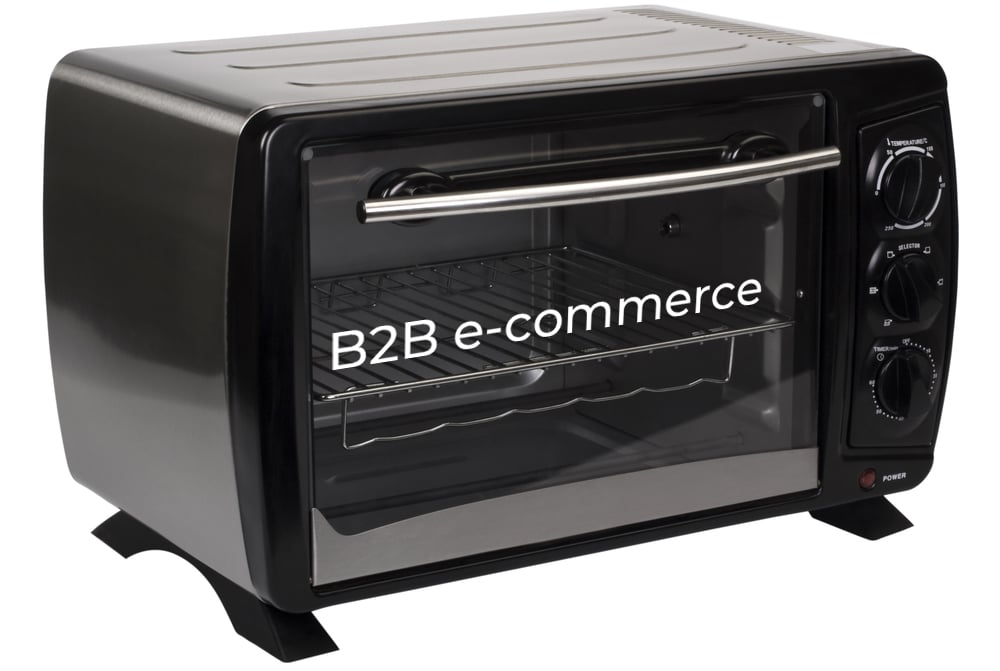
How to Do B2B e-Commerce Billions with Rob Neumann, Chief Strategy and Marketing Officer


What do you think are some of the benefits of having an engineering background as a marketer now?
[RN]: The first job of a marketer is to really communicate the value proposition of a company. I can walk in and understand perfectly what the company does and how they connect to their buyers. I primarily specialize in business-to-business (B2B) and I understand the financial buyer, the engineering buyer, as well as sales and marketing. All three of those are major influencers on what buys B2B. You’re selling a manufacturing product into a distributor, for example. It’s not about convincing a consumer. It’s about presenting the relevant information to convince a CFO (chief financial officer), CIO (chief information officer), and CEO (chief executive officer).
What was it like transitioning your career from engineer to marketer?
[RN]: Honestly, it was a lot of fun. My career has been about following two things — my heart and the money. Fortunately, they’ve gone hand-in-hand. I was fortunate in that my father said, “you’re going to engineering school, son.” I did, and what I found out is that engineering is not like it is in school. In fact, no career is really like what you learn in school. So I actually had a fabulous global career based in engineering and supply chain. I was about to work in treasury and currency as a finance major and it’s given me a global perspective. Then I figured out that I should learn to sell on someone else’s dime rather than mine. So I did that. I got an e-commerce career. I got a marketplace career in the energy industry and then I went and formed my own company. So that was probably the right thing to do because there isn’t a single entrepreneur who isn’t the lead sales person of their company.

What is B2B e-commerce and what does the success breakdown look like?
[RN]: The basic difference between consumer and B2B is that the basic underlying pieces are more complex and variable with technical products and B2B products. Take a product that you want to sell to a distributor; a toaster oven, for example. You’re going to have product variation in the end product because most manufacturer will take the same product and make small variations to sell into different markets. For example, most manufacturers aren’t selling in only one country, so there needs to be multilingual variations. Often, manufacturers will sell replacement parts or what we would call assemblies. In that case, you may have a shelf for toaster ovens, as well as a shelf for heating elements to another toaster oven manufacturer because you sell those as well. So you can sell parts, assemblies, full products, replacement products … and you have to be able to understand the hierarchy of it. It goes from everything from beautiful product photos to actual engineering drawings and specifications that you must provide.
In addition, most B2B manufacturers have more payment options. I’m not just taking your credit card; I usually have a purchase order set up. I may have bank transfers. I may have some sort of terms that are different for every client. The pricing is not only based on volume, it’s also based on your negotiated rate. As you can see, it begins to build in terms of complexity because almost every deal can be different. Data, data hierarchy and putting together your data management in a way that is consumable to your website while mixing in pictures, descriptions, marketing, product management, finance … it’s pretty complex.
The other interesting point is the supply chain is more complex for a B2B company. Why? Because I’m not just ordering a shirt in a dozen colors and sizes. Although that sounds like a lot of complexity, the truth is, we have minimum and maximum requirements for a part. Can I actually sell that part online or do I need to figure out that it goes into more value-added products like my complete product or an assembly. So your supply chain will need to be tightly integrated into your e-commerce. After all, no one likes to hear that although they sold something, they don’t actually have it. I like to call e-commerce “value chain re-engineering.”
Because of the environment we’re in now, everyone is realizing that we need to “pivot.” I’ve got traditional manufacturers who want to pivot into e-commerce and that presents some real challenges in terms of time-to-revenue and what it’s going to do to your accounts receivable.

What percentage of OEM (original equipment manufacturer) or middle manufacturers are NOT selling through B2B e-commerce but could?
[RN]: I’ll be honest, I think the United States lags behind Europe tremendously in this area. A lot of the best software and solutions for B2B are coming out of Europe. They have been approximately 10 years ahead. Why? If you think about it, within the United States, if we are selling in English, French, and Spanish, we have covered all of North America. From Mexico to Canada, there are essentially three primary languages and three currencies. In Europe, there are many more languages to consider. Europe only has one currency, fortunately. Then, if you go beyond Europe, which many of their manufacturers do, you have a lot of laws, regulations, and taxes to consider. So in Europe, they have been dealing with a higher complexity on their websites for a while now. The second reason for this lag behind Europe is that many manufacturers in the Unites States are focused on selling into large distributors and conducting business using old-fashioned way. They have focused heavily on their supply chain software, but have not really focused on being omnichannel.
Primarily, these manufacturers use a product called an ERP (Enterprise Resource Planning). It will handle your finances, inventory, part numbers, but they are also notorious for offering limited space for descriptions and other details (e.g., high-resolution product photos, technical drawings, marketing materials). So we need to bring together a lot of other systems, in which ERP is one. It’s critical that we integrate the information across the disparate systems to bring everything together.
It’s important to note that speed is still very important as well. In a B2C situation, every tenth of a second faster you get on mobile increases conversions. And it’s just as important on B2B systems, but we buy differently. B2B purchases are typically not impulse buys. They are longer decisions.

What would a company need to do in order to start, grow, and profit in B2B e-commerce?
[RN]: The typical (and in my opinion, right) way is to pull together your data from your ERP, Adobe systems, and marketing. This information would live in a product information database or product information management system. First, create your data hierarchy. Make sure your skus are properly put together. Often, during this process, you find holes in your information. Fill in the holes and then you can begin to build your e-commerce platform. Now I can tell you, almost everyone starts the other way. They start with the e-commerce platform, then figure out it’s not working and seek outside help.
Search is an important component to successful B2B e-commerce — if you can’t find it, you can’t buy it. So it’s important to make part numbers, manufacturing trade names, and special labels searchable.
In the pivot environment that we are in today, companies don’t have six to eight months to do this. So I advise my clients to focus on the 80/20 rule. It’s not my invention, but 20% of their products or less probably drive 80% of their revenue. So I just reduced the effort by 80%. Instead, focus on the 20% of your products. Develop your process. Perfect it. Doing so will allow you to compress the amount of time needed to get rolling.
We all know, whether you’re B2B or B2C, if you put up a website, it’s like putting up a sign in the middle of the Everglades. No one knows you’re there until you start advertising, sending out emails, optimizing your site for SEO. In the B2B arena, the most used e-commerce platform is Magento.
If I’ve done an 80/20 effort, what’s the fastest way to get revenue? Well, that’s called syndication. You can either pull straight from your website, or put it up on a marketplace. Right now, there are three major players that have obvious implications. One of those players is Amazon B2B, which is growing incredibly fast. You can get your products onto Amazon B2B and in front of clients much faster than trying to put your whole website up. Another option, which I have a special partnership, is eBay. Believe it or not, they are trying really hard to figure out how to relevantly compete with Amazon; and they believe B2B has an area that they can compete. eBay’s bidding mechanism is actually part of the B2B procurement landscape. The third option that is making a very hard entrance into the United States is Alibaba, which is a Chinese company that rivals in size of Amazon in China and lots of us in the procurement industry have been using it to pull in products from China. Alibaba is making an effort to enroll U.S. manufacturers and clients to be able to work strictly within the United States. There are a couple of advantages to Alibaba right now. First, it would eliminate the need to ship overseas from China. Second, they have an RFQ (request for quote) process, which Amazon and eBay do not. This enables custom manufacturers and service manufacturers to participate in e-commerce in a way they have never been able to before.

Do you think there will be more resistance in the U.S. market, given recent events from China, to leverage a platform like Alibaba?
[RN]: We don’t know the full implications, but what I can tell you is that U.S. companies are signing up. They don’t have as large a presence in the U.S., but some companies are signing up. Alibaba has a presence in Europe already, and they have some unique advantages. What we’ll find out is whether those advantages are enough to overcome the fact that they are owned in China. I think the bigger problem is not that they are owned in China, but that B2B procurement professionals only think about them in terms of buying something from China. Changing that thinking is going to take some real effort. One thing they have, though, that is a real advantage is the RFQ process. That doesn’t exist on any other platform.
Anything else you’d like to share?
[RN]: I think we should break B2B e-commerce down to four things.
- Understand and organize your data.
- Determine what you are trying to accomplish. For example, are you trying to cut out the distribution component and go direct to the customer?
- Figure out how you will hook everything up.
- Establish your supply chain.

As the architect of digital systems Rob creates immediate opportunities for growth of the 20% or more top line revenue growth. Holding degrees in Engineering and Business, his career spans 25 years of manufacturing, tech, advertising, product development and services business. Check out Rob’s B2B e-Commerce digital conference details.
Connor Dube is Sales & Marketing Director at Active Blogs, an industry leader in B2B social selling and content strategy, Co-Founder of the Mile High Mentors Podcast, and Founder of B2B Mentors. Building his first business at seven, he’s gone on to create multiple companies and supporting his clients approaches to adding multiple 8-figures to their sales pipeline with his innovative approach to Social Selling. As a current leader in sales and marketing strategy for complex industries, Connor’s been featured in top podcasts, resources, and stages, including MSU Denver’s current sales and marketing curriculum.
Connect with Connor on LinkedIn: https://www.linkedin.com/in/socialsellingexpert/ or email him at connor@activeblogs.com





